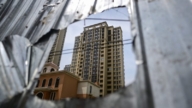【新唐人2014年01月23日讯】海外媒体日前报导了中国严重的债务问题。在经济发展中,像大陆这么高的负债率是必然的吗?这些债务怎么产生的?如何偿还掉?对老百姓和北京当局都有什么影响?为什么经济学家们把大印钞票称之为“危险的掠夺”?让我们听听专家们的分析。
法国媒体《解放报》日前在经济版发表长篇文章,题目是“北京背上沈重的债务”。报导说,中国的公共债务已经占国内生产总值的58%,而四年前只有17%。公共债务与私营企业的债务加起来,已达到215%,2008年则是131%。
文章指出,中国债务的增速过快,其中主要是地方政府的债务,在两年半里增加了67%,达到2万2千亿欧元。许多地方政府深陷泥潭,不得不继续大量借款来偿还利息。
北京“师范大学”MBA导师,经济专栏作家段绍译认为,经济的发展肯定需要融资,融资肯定会增加负债,但是像中国这么高的负债率,并不是经济发展的必然副产品。因为,债务分良性和不良债务。
北京师范大学MBA导师段绍译:“因为有些债务是良性的债务,有些债务是不良债务。良性的债务它能够产生新的财富。借钱的人赚更多钱,债权人得到更多的利息。如果是不良债务,不能产生新的财富,结果债还不起。”
报导引述美国经济学家佩蒂斯的话说,在中国,大部分投资是用在修建无人居住的房屋、和无人使用的高速公路或机场,以及无用的工厂等。
中国的“鬼城”林立,从北方的鄂尔多斯到南方的三亚,从富裕的浙江温州到贫困的宁夏海原。“鬼城”不仅为国人所知,而且已经被西方媒体经常报导。
段绍译:“这里面很大一部分就属于不良债务。它不能产生新的财富,是因为这些投资主要是政府行为,都是不理性的。他就是花别人的钱,办自己的事。他不讲节约的。”
除了“鬼城”之外,大陆各地近年兴建的大量豪华建筑,也令西方人“目瞪口呆”。《解放报》的报导指出,在安徽的一个小镇上,当地政府建了一座与美国五角大楼一样大的办公大楼。另外,北京、武汉、重庆、广州等大城市,一共建了60到100座摩天大楼。
段绍译说,这样产生的债务,给当局带来严重的信任危机。
段绍译:“不良债务就是对资源的浪费,就是真正的财富减少了,老百姓真正的福利受到影响。政府不能及时清理这些债务的话,让老百姓对政府失去信心了。一个国家的农民对政府失去信心的话,只能是灾难性的。”
旅美经济学家程晓农指出,地方政府解决债务问题的办法,是由中央政府所属的银行来承担。他分析:中央政府不可能让自己的银行破产,导致政权垮台,所以他们就印钞票,也就是用通货膨胀的办法来稀释债务。
程晓农相信:中共最后不是被地方债直接拖垮,而是被地方债带来的通货膨胀拖垮。
中国“浙江大学法律与经济学研究所”创办人之一,学者庄道鹤认为,债务沈重肯定对中国经济发展有压力,但是由于体制的原因,当局会用非正常的方式解决。
中国“浙江大学”教师庄道鹤:“毫无疑问,否则就不会有当年的四万亿救市这个行动。但是因为是共产党执政的国家,它占有了全部的国民经济资源,包括物资的、人力的,因此它可以以透支的方式,不顾子孙后代发展,进行掠夺性的、破坏性的开发。”
大陆财经评论员,财经专栏作家“牛刀”也认为,从2009年开始,中共大印钞就是“彻头彻尾的掠夺全民财富的一场金融行为”,他警告:这是“很危险的”,很多政权都葬送在印钞上。
采访编辑/唐音 后制/萧宇
Public debt accounted for 58% GDP
Expert: Big plundering with big money printing
Overseas media recently reported on the serious debt
problems in China.
Is the high continental asset ratio inevitable in
this economic development?
How can these debts be incurred? How can they be paid off?
Is there any impact on the people and Beijing authorities?
Why do Economists call money printing a “dangerous game"?
Let’s take a look at the experts’ analysis.
French newspaper “Liberation" recently published a long article
in the business section titled, “Beijing’s heavy debts".
The article says China’s public debt is already accounted for
by 58% of GDP, while only being 17% four years ago.
Public debt and private sector debt together have reached 215%
of GDP while only being 131% in 2008.
The article pointed out China’s fast growing debt problem is
mainly because of local government debt.
It increased by 67 percent to 2.2 trillion euros in 2.5 years.
Many local governments are in a deep pit and have to continue
to borrow heavily to pay interest.
Beijing Normal University MBA mentor, economic columnist
Duan Shaoyi believes that economic development will certainly
require financing, thus increasing liability.
China’s high debt ratio is not the inevitable by-product of
economic development because the debt includes
good debt and bad debt.
Beijing Normal University MBA mentor Duan Shaoyi: good
debt can generate new wealth, which means borrower can make
more money and creditors can receive more interest.
Bad debt means it cannot produce new wealth and the borrower
cannot pay off the debt.
An article quoted American economist Pettis’s word that most
of China’s investment is used in the construction of
uninhabited houses, useless highways or airports,
as well as useless factories.
“Ghost towns" are everywhere in China from the northerly Ordos
to the southerly Sanya, from the wealthy Wenzhou to the poor
Haiyuan of Ningxia.
“Ghost Towns" are not only known by the Chinese people but
frequently reported on by Western media.
Duan Shaoyi: There is a large part of bad debt that can’t
generate new wealth.
These investments are mainly irrational government actions.
They just do their own thing using other people’s money, not
talking about saving.
In addition to the ghost towns, a large number of continental
luxury buildings in recent years have also stunned
the Western world.
“Liberation " reported that there is a same government
building as the Pentagon in a small town in Anhui.
In addition, there are 60-100 skyscrapers in Beijing, Wuhan,
Chongqing, Guangzhou and in other big cities.
Duan Shaoyi said that the debt has brought a serious
crisis of confidence for the authorities.
Duan Shaoyi: bad debt is a waste of resources and reduction
of real wealth which will affect people’s benefits.
People will lose confidence in the government if these debts
cannot be cleaned up.
It will be disastrous if farmers lose their confidence
in the government.
US economist Cheng Xiaonong pointed out that the local
government’s solution of the debt problem is to let
government-owned banks undertake.
He analyzed: The central government will not make their own
banks fail, leading to the collapse of the regime; so they may
print money and dilute debt via inflation.
Cheng Xiaonong believes: The Chines Communist Party’s (CCP)
imminent collapse is not because of local bonds but
the inflation from local bonds.
One founder of the Law and Economics Institute in Zhejiang
University, scholar Zhuang Daohe believes that heavy debt
certainly added more pressure to China’s economic development,
but the authorities will use an abnormal solution
due to the system.
China Zhejiang University Teacher Zhuang Daohe: There is no
doubt, or there wouldn’t have been 40,000 trillion
bailout bills that year.
The authorities, who are the CCP have taken possession of all
the national economic resources,
including materials and manpower.
So it can engage in predatory and destructive development by
means of overdrawing disregarding development
for future generations.
Mainland financial commentator, financial columnist “chopper"
also believes that from 2009, the CCP’s money printing
represents financial behavior of downright
plundering national wealth.
He warned it to be very dangerous because many regimes are
buried in printing money.
Interview & Edit/TangYin Post-Production/XiaoYu




























